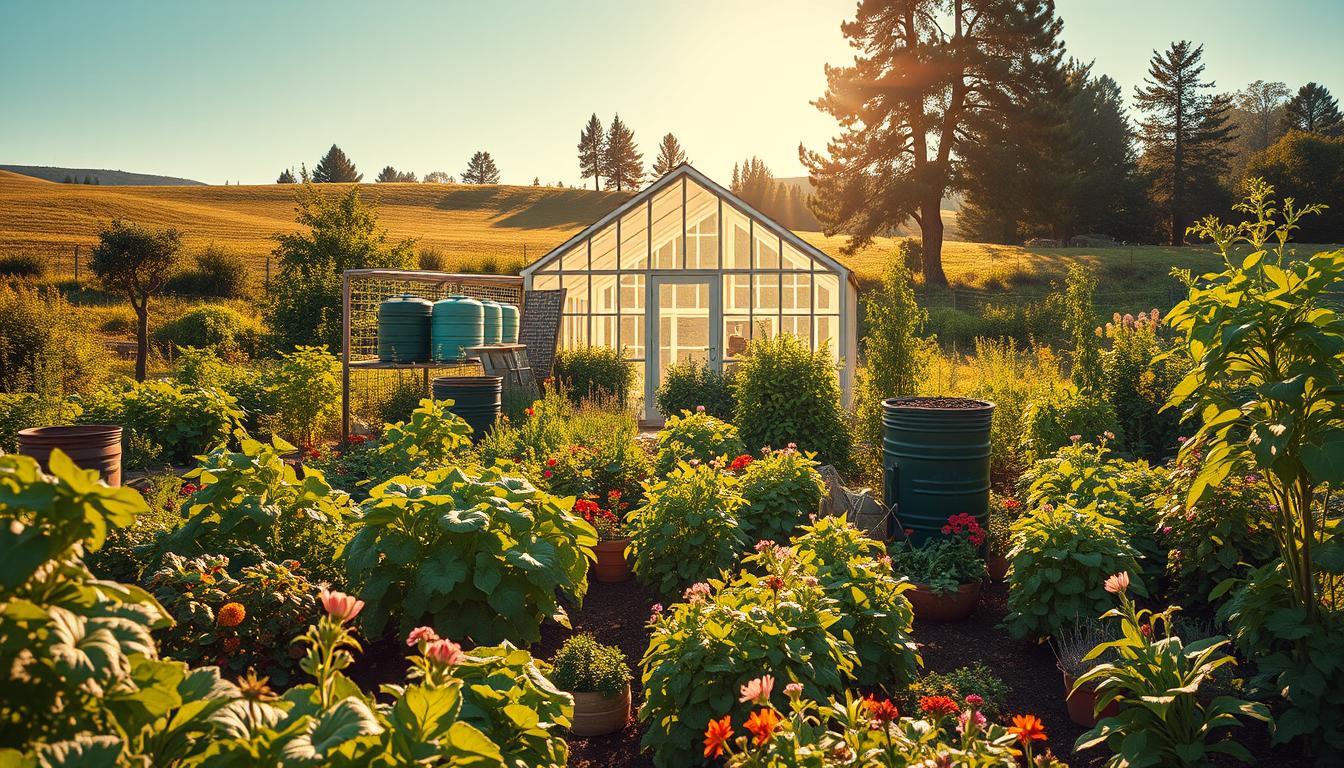Do you remember when gardening meant lots of plastic and chemicals? We thought it was the only way to grow plants. But there’s a greener way that’s better for both plants and our planet.
Zero waste gardening is all about using everything over and over. It’s different from old ways that waste a lot. Now, coffee grounds are fertilizer, and cardboard keeps weeds away.
By using these methods, gardeners save a lot of money. They make their own soil and reuse things. It’s also very fulfilling to create a garden that takes care of itself.
Starting a zero waste garden is easy, no matter how big or small your space is. In this guide, we’ll show you how to make your garden waste-free. You’ll learn simple steps to create a beautiful, sustainable garden, no matter your experience.
The Environmental Impact of Traditional Gardening
Traditional gardening may look green and peaceful, but it has hidden environmental costs. It can harm the environment, even though it connects us with nature. Common practices like using too much water and chemicals go against the values of gardening.
Switching to sustainable gardening is more than a trend. It’s a response to the need to protect our planet. Many gardeners are surprised to find their efforts might harm the environment instead of helping it.
Common Wasteful Practices in Modern Gardening
Many gardeners unknowingly waste water and resources. Sprinkler systems often waste water, and a lot is lost to evaporation. In the US, outdoor water use is nearly 30% of household water.
Plastic waste is another big problem in gardens. From pots to tools, plastic items quickly add up. They often end up in landfills, despite being used for natural products.
Chemical fertilizers and pesticides harm soil and create a cycle of dependency. Yard waste, like leaves and grass clippings, is often thrown away instead of being reused in the garden.
The Hidden Carbon Footprint of Garden Products
The environmental cost of gardening goes beyond our yards. Commercial products have a big carbon footprint that’s often hidden. Fertilizers need a lot of energy to make, and nitrogen fertilizers alone use 3% of global natural gas.
Transporting garden supplies adds to the problem. They often travel long distances, burning fossil fuels. Even simple products like peat moss harm the environment, as peat bogs are essential carbon sinks.
Plastic garden accessories also have hidden costs. They require a lot of resources to make and can’t be recycled. By understanding these costs, gardeners can choose more eco-friendly options and reduce their impact.
Understanding Zero Waste Gardening Principles
Zero waste gardening starts with the idea that nature doesn’t have waste. Every leaf, insect, or fruit has a role in the ecosystem. This idea is the base of gardening that works with nature’s cycles.
It’s not just about cutting down trash. It’s about changing how we grow plants. We see our gardens as complete systems where resources keep moving in circles, not just one way to the trash.
By following these principles, our gardens become more self-sufficient. They need less from outside, make less waste, and grow healthier plants. This is because we use methods that are like nature’s own design.
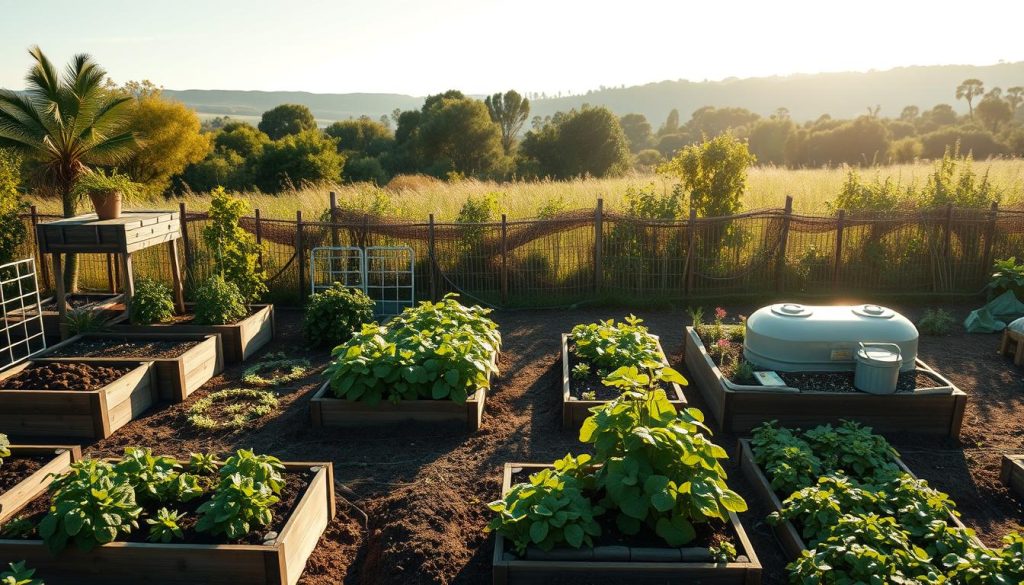
The Philosophy Behind Closed-Loop Systems
Closed-loop gardening is at the heart of zero waste. In these systems, what goes out becomes what comes in, making endless cycles without waste. This view changes how we see garden materials—nothing is truly thrown away when it has value.
This philosophy goes beyond just composting (though that’s key). It covers all garden management, from starting seeds to harvesting and back again. By closing these loops, gardens become stronger and less reliant on outside help over time.
Here are some examples of closed-loop systems in your garden:
- Composting kitchen scraps and garden trimmings to make soil amendments
- Saving seeds from your best plants for next year
- Using pruned branches as trellises or mulch
- Capturing rainwater for irrigation during dry times
- Growing plants to feed beneficial insects and pollinators
How Zero Waste Gardening Mimics Natural Ecosystems
Nature has perfected waste-free systems over billions of years. In a forest, leaves decompose to feed soil, which then feeds trees. Dead wood is home to insects, which feed birds. Water moves through plants, soil, and air in endless cycles.
Zero waste gardening takes inspiration from these natural systems. By studying how nature works without us, we can design gardens that work with nature’s patterns, not against them.
When we copy natural ecosystems in our gardens, we get many benefits:
- Natural pest control through diversity and predator-prey
- Soil health through constant organic matter cycling
- Water saving through the right plants and soil
- Less maintenance as the garden becomes more self-regulating
The beauty of these systems is their efficiency. Nothing is wasted because everything has multiple uses. A flower doesn’t just look good—it feeds pollinators, creates seeds, adds to soil, and may even keep pests away. This multi-use approach is crucial for successful closed-loop gardening.
Getting Started: Planning Your Zero Waste Garden
Starting a zero waste garden is all about planning. It’s about turning what you have into something great. By planning carefully, you can grow a lot with little waste.
This planning stage is key. It’s where you lay the groundwork for a garden that needs less and wastes less.
Site Assessment and Resource Mapping
First, check out your garden space. See how much sun each area gets. Test your soil to know what to plant without using chemicals.
Make a map of your property. Mark where you have water, trees, and where waste piles up. See how you can use kitchen scraps and leaves in your garden. This helps you use what you have instead of throwing it away.
Designing for Minimal External Inputs
After assessing your site, design your garden to need less from outside. Plant different things together to keep pests away and avoid using chemicals.
Think about how water moves in your garden. Put plants that love water in wet spots and those that don’t in dry ones. This way, you won’t overwater or underwater.
Use free materials for paths. This lets you walk around without hurting your soil. Add features that do more than one thing, like a wall for insects or a pond for water and wildlife.
Selecting Plants for Sustainability
Pick plants that do well in your area with little care. Native plants are best because they need less water and care than others.
Choose plants that come back every year. This saves you work and resources. Look for plants that do more than one thing, like bushes that give food and help insects.
Start with a few plants that fit your garden perfectly. Then add more as you learn what works. Sustainable gardening is about going with nature, not against it.
Creating Rich Soil Without Commercial Products
Building healthy soil without commercial amendments is key in zero waste gardening. It saves money and turns waste into a valuable resource. This process feeds your plants naturally.
Healthy soil is full of microorganisms that turn organic matter into nutrients. Composting speeds up this natural process and keeps waste out of landfills. You can adjust your composting to fit your space.
Building Compost Systems for Different Spaces
Composting works in any space, from apartments to homesteads. The trick is to choose a system that fits your area and waste.
For small spaces, a bokashi system is great. It turns kitchen scraps into compost in a sealed bucket. This method is odor-free and works well indoors.
For a bit more room, cold composting is easy. Just pile organic materials and let them decompose slowly. It’s low effort but takes longer.
Hot composting is best for larger spaces. It decomposes waste quickly with the right conditions. You can get compost in 4-6 weeks with regular turning.
| Composting Method | Space Required | Time to Completion | Maintenance Level | Best For |
|---|---|---|---|---|
| Bokashi | Very Small (1-2 sq ft) | 2-4 weeks (fermentation) | Low | Apartments, all food scraps including meat/dairy |
| Cold Composting | Medium (3-4 sq ft) | 6-12 months | Very Low | Casual gardeners, plant matter only |
| Hot Composting | Large (4+ sq ft) | 4-6 weeks | High | Dedicated gardeners, plant matter only |
| Vermicomposting | Small (2-3 sq ft) | 3-6 months | Medium | Indoor/outdoor, most kitchen scraps except citrus/onions |
Vermicomposting: Letting Worms Do the Work
Vermicomposting uses worms to make rich soil. These worms turn kitchen scraps into nutrient-rich castings that plants love.
To start, you need red wigglers or European nightcrawlers. These worms thrive in worm bins and break down waste efficiently.
Your worm bin can be simple or complex. Start with shredded newspaper, cardboard, or coco coir as bedding. Keep it moist like a wrung-out sponge.
Feed your worms fruit and veggie scraps, coffee grounds, and crushed eggshells. Avoid meat, dairy, oily foods, citrus, and onions to prevent odors and harm. A healthy bin should smell earthy, not rotten.
Harvesting worm castings is easy. Move finished material to one side and add fresh food to the other. The worms will move toward the food, letting you collect the castings. This black gold is a powerful fertilizer and soil amendment for your plants.
Water Conservation Techniques for the Sustainable Garden
Turning your garden into a water-saving oasis is key. With unpredictable weather and water limits, saving water is crucial. Eco-friendly gardening not only helps the planet but also saves money on water bills.
Using smart water management, your garden will thrive even when it’s tough. These methods help your garden work with nature, using every drop wisely.
Rainwater Harvesting Systems
Rainwater is free and clean. Capturing it is a basic step in eco-friendly gardening. A small roof can collect a lot of water from just one inch of rain.
Setting up a rainwater system is easy or complex, depending on your needs. Start with a food-grade barrel under a downspout. Add a spigot for easy access. For more advanced systems, use first-flush diverters to keep the water clean.
Calculate how much water you can collect. Use the formula: Roof square footage × 0.6 × inches of rainfall = gallons collected. This helps you choose the right size for your system.
Greywater Recycling for Gardens
Greywater from sinks, showers, and washing machines can water your garden. It saves a lot of water and closes the water cycle in your home.
Not all greywater is safe for gardens. Kitchen water can attract pests. Bathroom and laundry water is safer. Use plant-friendly detergents for laundry water.
Use greywater for fruit trees, ornamentals, and perennials. Avoid using it for vegetables or leafy greens. Simple systems collect shower water, while more complex ones distribute water to different areas of your garden.
Mulching and Other Water-Saving Strategies
Mulching is a simple yet effective way to save water. A 2-3 inch layer of organic mulch can cut down water evaporation by up to 70%. It also keeps weeds away and improves soil health.
Choose local materials for mulch, like straw or leaves. Apply it after watering, keeping it away from plant stems to prevent rot.
Other water-saving strategies include:
- Drip irrigation delivers water directly to roots, saving up to 90% of water compared to sprinklers
- Ollas (unglazed clay pots) slowly release water to roots
- Hydrozoning groups plants with similar water needs together
- Watering deeply but infrequently encourages deeper root growth
| Water Conservation Method | Water Savings | Setup Cost | Maintenance Level | Additional Benefits |
|---|---|---|---|---|
| Rainwater Harvesting | 50-100% of irrigation needs | $20-500+ | Low to Moderate | Reduces stormwater runoff, provides chlorine-free water |
| Greywater Systems | 30-50% of household water | $0-300 | Moderate | Reduces water bills, decreases strain on septic systems |
| Organic Mulching | 50-70% reduction in evaporation | $0-50 | Low | Improves soil health, suppresses weeds, moderates soil temperature |
| Drip Irrigation | 30-70% compared to sprinklers | $50-200 | Low to Moderate | Reduces plant disease, precise water delivery |
| Ollas/Clay Pot Irrigation | 50-70% over conventional watering | $5-30 per pot | Very Low | Ancient technique, works without electricity, steady moisture |
Zero Waste Gardening: From Seed to Harvest and Back Again
Zero waste gardening is a beautiful journey from seed to harvest and back. It eliminates waste, unlike traditional gardening. This method turns your garden into a self-sustaining ecosystem.
It reconnects us with traditional growing practices. Gardeners can complete natural cycles without artificial products and waste streams.
Embracing these cycles makes your garden more resilient and productive. It becomes harmonious with nature. The two key cycles are seed saving and soil fertility through nutrient cycling.
Mastering these practices reduces dependence on external resources. Your garden will improve with each season.
Seed Saving and Swapping Networks
Saving seeds is key to sustainable gardening. Start with easy plants like tomatoes, beans, lettuce, and peas. These varieties produce seeds that grow true to their parents.
To save seeds, let your healthiest plants mature fully. For tomatoes and cucumbers, scoop out seeds and ferment them. Then, rinse and dry them thoroughly. Beans and peas need to dry completely on the plant before harvesting.
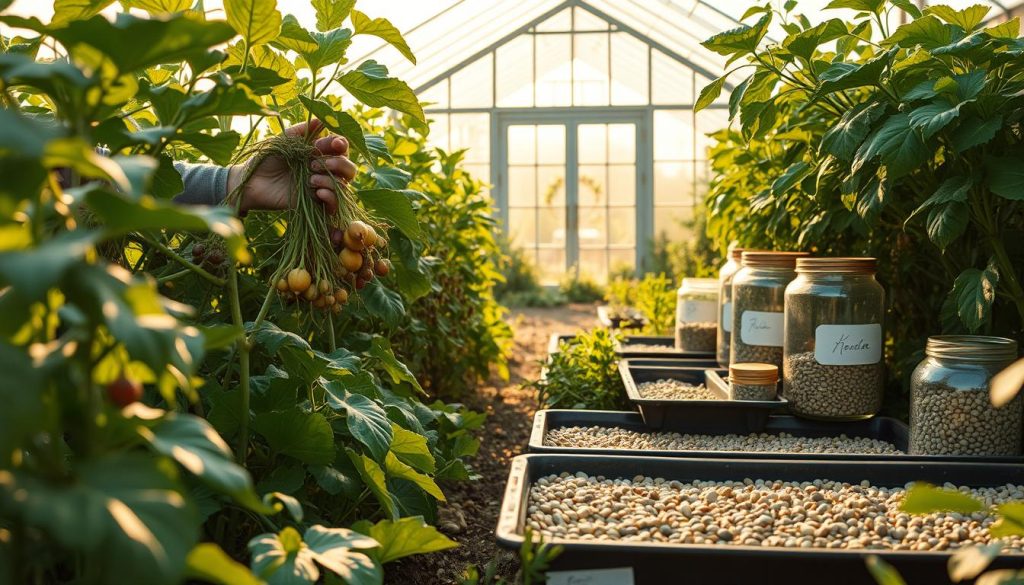
Join local seed libraries and swapping networks to grow your collection. These resources help gardeners exchange seeds adapted to local conditions. This reduces the need for purchased seeds and preserves biodiversity. Many libraries and online platforms like Seed Savers Exchange help connect gardeners.
Creating Closed Nutrient Cycles
The second key loop in zero waste gardening is keeping nutrients cycling. Commercial gardens often use synthetic fertilizers. Closed-loop gardening mimics natural ecosystems where nutrients recirculate.
Use chop-and-drop mulching to return nutrients to the soil. Cut spent plants at soil level and leave them there. This protects the soil from erosion and moisture loss. Plants like comfrey are great for mulch because they mine minerals from subsoil.
Green manures like clover, buckwheat, or winter rye can be grown to nourish soil. These cover crops protect soil between plantings and add organic matter. Use composting systems in garden beds to retain nutrients.
By closing both seed and nutrient loops, your garden becomes self-sufficient. Plants grown from saved seeds resist local pests and diseases. Soil built through nutrient cycling grows richer and more balanced each year. This creates a thriving ecosystem that produces abundance with minimal external inputs.
Upcycling and Repurposing in the Garden
Upcycling in the garden turns trash into treasures, making your garden unique. It saves money and helps the environment. You’ll find new uses for everyday items, turning them into planters and supports.
Upcycled gardens have a special charm that new items can’t match. Each item has a story, adding character to your garden. It also makes you see the world in a new way, finding garden treasures everywhere.
Creative Container Gardens from Reclaimed Materials
Anything that can hold soil can become a planter. Old boots are great for herbs, and colanders are perfect for succulents. Wooden crates and broken teapots also make great planters with a little work.
When picking items for container gardening, think about drainage and safety. Make sure materials won’t harm your plants. Avoid items like old tires and some plastics that might leach chemicals.
Displaying different containers adds interest and starts conversations. Use old bricks or stumps for height. An old wheelbarrow can move around, and a dresser can cascade plants.
Building Garden Infrastructure Without Buying New
Big projects also benefit from upcycling. Wooden pallets make great vertical gardens or raised beds. Old windows can extend your growing season without extra energy costs.
Use old bed frames, bike wheels, or branches for trellises. These not only support plants but also add beauty to your garden. Broken concrete can be used for walls or stepping stones.
When working with old materials, be safe. Sand rough spots, remove nails, and clean well. For wood, a non-toxic sealer can help it last longer without harming the environment.
Don’t worry about imperfections in upcycled gardens. The weathered look adds charm. Your garden becomes a showcase of your commitment to sustainability.
Permaculture Principles in Zero Waste Growing
Permaculture turns any garden into a self-sustaining system with little to no waste. It designs systems that work with nature, not against it. This approach helps gardens be productive, resilient, and need less outside help.
Permaculture looks at nature and applies its patterns to our gardens. In zero waste gardening, it creates systems where waste is turned into useful inputs. This way, gardeners can grow more with less waste and harm to the environment.
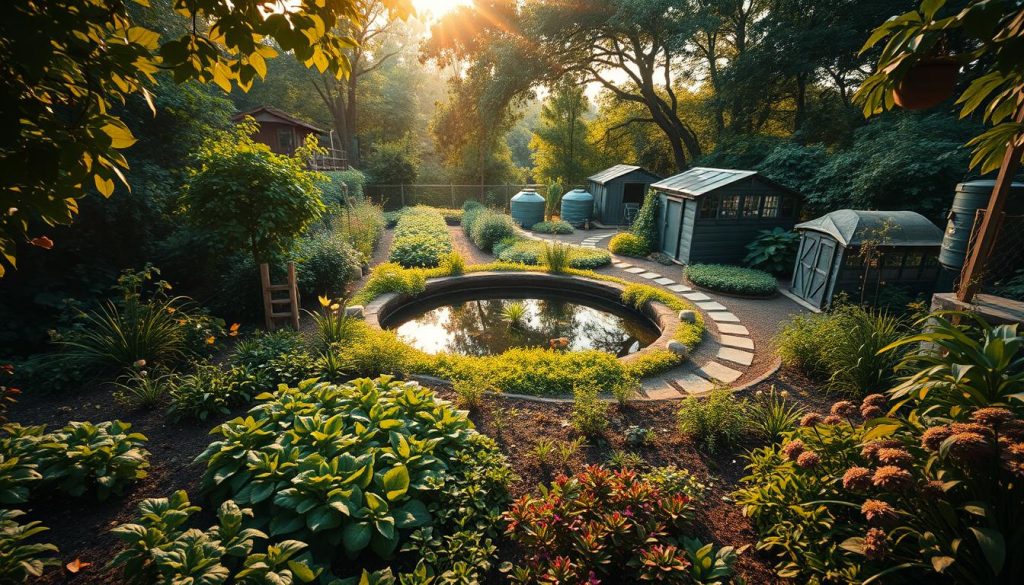
Integrating Permaculture Zones in Limited Spaces
Permaculture uses zones to organize the garden by how often it needs care. Zone 1 is for daily needs like herbs and greens. Zones further out need less attention.
Urban balconies can use this idea too. Zone 1 might be herbs by the door. Zone 2 is for veggies that need regular water but less picking. Even small yards can use this by placing thirsty plants near water sources.
Permaculture zoning in small spaces is efficient. It places high-maintenance plants where you’ll naturally care for them. This saves effort and resources. For example, a suburban gardener might have a kitchen garden near the house, with fruit trees and perennials further out.
Stacking Functions: Getting More from Every Element
Permaculture says every element should do more than one thing. This “stacking” reduces waste by using each part of the garden to its fullest. Instead of single-use features, permaculture promotes multi-functional design.
A trellis is a great example. In a permaculture garden, it supports climbing plants, shades sensitive crops, and acts as a windbreak. It also collects dew for irrigation and homes beneficial insects. One structure, five functions!
Plants can also serve multiple purposes. Comfrey, for example, has deep roots that gather nutrients, attracts pollinators, and provides medicinal leaves. It also makes rich mulch when cut back. By choosing plants that do many things, your garden does more with less, following the zero waste philosophy.
Natural Pest Management Without Plastic or Chemicals
Getting rid of chemical pesticides and plastic traps doesn’t mean your garden will be overrun by pests. It means working with nature’s defense systems. In organic gardening, pest control is about balance, not war. Healthy ecosystems have built-in pest control that works without harming the environment.
The zero waste approach to pest management sees some insects as good for your garden. It aims to keep pest populations low while supporting beneficial organisms. This balance keeps your garden healthy.
Companion Planting Strategies
Companion planting uses plants’ natural relationships to fight pests. Some plants repel certain insects or hide the scent of other plants. This is done through their oils and root exudates.
Marigolds repel nematodes and many insects with their strong scent. Nasturtiums draw aphids away from vegetables. Basil near tomatoes improves their flavor and keeps hornworms away.
| Vulnerable Plant | Companion Plant | Pest Deterred | Additional Benefit |
|---|---|---|---|
| Cabbage family | Thyme, Rosemary | Cabbage moths | Attracts pollinators |
| Carrots | Onions, Leeks | Carrot fly | Maximizes space usage |
| Tomatoes | Basil, Marigolds | Hornworms, Nematodes | Improves tomato flavor |
| Cucumbers | Nasturtiums, Radishes | Cucumber beetles | Provides ground cover |
Encouraging Beneficial Insects and Wildlife
Creating a home for helpful creatures is a top pest management strategy. Ladybugs, lacewings, and wasps eat many pests. They can eat hundreds of insects in their lifetime.
To attract these helpers, plant diverse flowers that offer nectar and pollen. Dill, fennel, and Queen Anne’s lace attract beneficial insects. Leave some areas wild with leaf litter and hollow stems for them to overwinter.
Water features, like a shallow dish with stones, attract birds and beneficial insects. Birdhouses, bat boxes, and insect hotels provide shelter. They bring natural pest controllers into your garden.
Homemade Pest Deterrents
When you need extra help, homemade solutions can be effective. They use common ingredients and plants to fight pests without harming the environment.
Garlic-pepper spray is great against aphids and caterpillars. Blend 4 cloves of garlic and 2 hot peppers with 2 cups of water, then strain and spray. For fungal issues, a baking soda solution (1 tablespoon per gallon of water with a drop of liquid soap) prevents powdery mildew.
Diatomaceous earth, made from fossilized algae, dehydrates crawling insects. Sprinkle it around plants to deter slugs, ants, and other pests. Remember, it affects beneficial insects too, so use it carefully.
The beauty of these natural methods is how they work together. Each one supports the others, creating systems that get better over time. As you garden organically, you’ll need to intervene less and harvest more.
Regenerative Practices for Long-Term Garden Health
Regeneration in gardening goes beyond just sustainability. It’s about healing and enriching the environment with each season. Unlike sustainable gardening, which aims to keep resources steady, regenerative gardening improves soil health and biodiversity. It turns your garden into a carbon sink, fighting climate change while giving you plenty of food.
Regenerative gardening works with nature’s cycles, making your garden better with each year. Instead of adding outside inputs, it builds its own fertility and strength. Let’s see how to start these powerful practices in your garden.
Building Soil Instead of Depleting It
Healthy soil is the heart of regenerative gardening. Unlike old methods that take away nutrients, regenerative gardening adds to soil health. It’s all about minimizing disturbance and adding organic matter.
No-dig gardening is a key soil-building method. It keeps soil structure intact, protecting the underground ecosystem. Just add organic materials to the surface, and nature will mix them in.
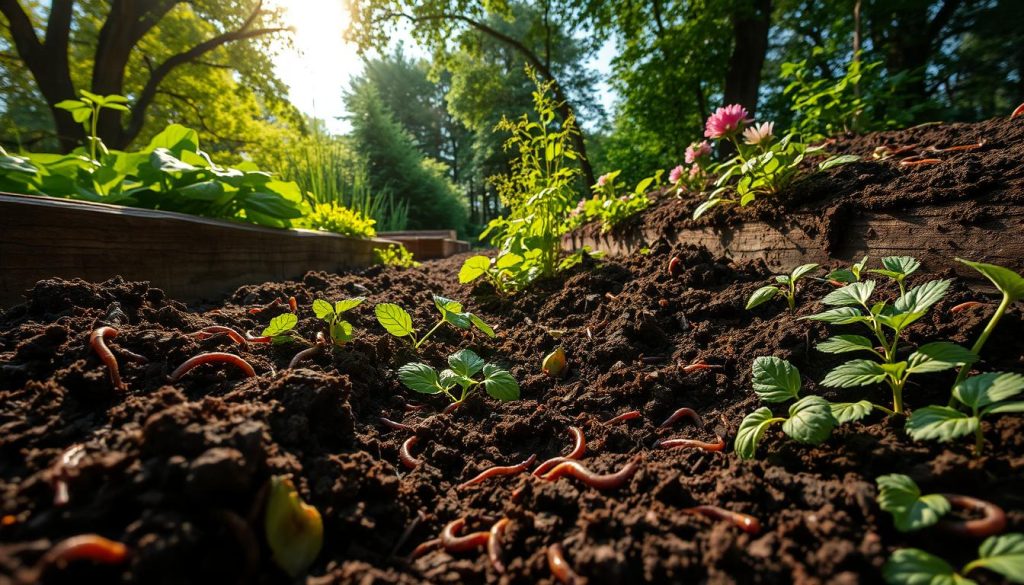
Cover crops are vital for soil regeneration. Plants like clover and rye prevent erosion and add nutrients. When cut down, they act as mulch, feeding soil life without tilling.
Biochar is charcoal made for soil improvement. It stores carbon and supports beneficial microbes. Charged with compost tea, biochar boosts soil regeneration.
Creating Resilient Garden Ecosystems
A regenerative garden doesn’t just survive—it thrives. It’s built to withstand drought, heavy rains, and pests. This means creating systems that can handle any challenge.
Polyculture planting grows many species together. This natural insurance ensures your garden stays productive, even when conditions are tough. It’s like a natural ecosystem, where diversity keeps things stable.
Creating microclimates helps protect plants from extreme weather. Berms, swales, and stones or logs create sheltered spots. They also help manage water, capturing it during rains and releasing it in dry times.
Genetic diversity adds another layer of resilience. Growing many varieties of each crop means some will always do well. This also saves valuable genetic traits from being lost.
| Regenerative Practice | Environmental Benefit | Implementation Difficulty | Time to See Results |
|---|---|---|---|
| No-dig gardening | Carbon sequestration, soil life protection | Easy | 1-2 seasons |
| Cover cropping | Erosion prevention, nitrogen fixation | Moderate | Single season |
| Biochar application | Long-term carbon storage, water retention | Moderate | 2-3 seasons |
| Polyculture planting | Biodiversity increase, pest reduction | Moderate | Immediate |
| Microclimate creation | Water conservation, habitat creation | Challenging | 1-3 seasons |
Even small gardens can be regenerative powerhouses. A single raised bed can sequester carbon, boost biodiversity, and grow more food each year. Regenerative gardening works on any scale, from balconies to farms, making a positive impact and rewarding you with more food.
As your garden gets healthier, you’ll see fewer pests, better water use, and plants that need less care. It’s not magic—it’s just working with nature’s systems instead of fighting them.
Cultivating a Zero Waste Mindset: Beyond the Garden
The skills you learn in zero waste gardening don’t stop at your garden. When you pick vegetables, think about saving extra by freezing, canning, or fermenting. These methods use little packaging and connect you to old ways of food making.
Your kitchen can be like an extension of your garden. Use veggie scraps in soups, make pesto from carrot tops, and grow lettuce again in water. These actions create the same cycles you’ve set up outside.
When buying garden stuff, choose secondhand tools, biodegradable pots, and items with no plastic. Many garden stores take back plastic pots for reuse. Just ask before throwing it away.
Building a community helps your zero waste gardening. Join seed libraries, swap plants, or share garden goodies with neighbors. These actions cut down on waste and build strong local ties.
Zero waste gardening isn’t about being perfect. It’s about making choices that help the planet and connect you to nature. Every small action, like composting or saving seeds, helps our planet.
As your garden grows, so does your understanding of waste and resources in life. This effect is the most valuable thing from your zero waste garden. It’s a mindset that sees value in everything, cycles, and abundance.

